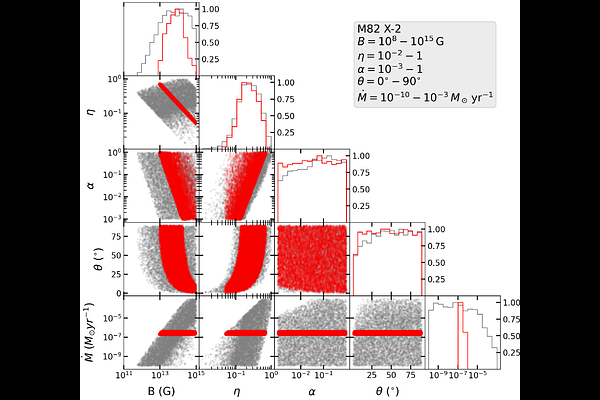Wobbling around the clock: magnetically-driven quasi-periodic oscillations in pulsating ultraluminous X-ray sources

Wobbling around the clock: magnetically-driven quasi-periodic oscillations in pulsating ultraluminous X-ray sources
M. Veresvarska, M. Imbrogno, R. Amato, G. L. Israel, S. Scaringi, P. Casella, D. de Martino, F. Fürst, A. Gúrpide Lasheras, C. Knigge, M. J. Middleton
AbstractUltraluminous X-ray sources (ULXs) are X-ray binary systems containing an accreting neutron star (NS) or black hole emitting at luminosities above the Eddington limit of a $10M_{\odot}$ black hole. Approximately 1900 (either confirmed or candidate) ULXs have been identified to date. Three systems have been confirmed to exhibit coherent signals consistent with NS spin frequencies and quasi-periodic oscillations (QPOs) in the mHz range. Several interpretations for generating such QPOs have been proposed, including general relativistic frame-dragging effects. In this work, we test if an alternative model in which magnetically-driven precession of the inner accretion flow can self-consistently reproduce the observed NS spin and QPO frequencies for reasonable values for accretion rates and NS magnetic field strengths. For a range of parameters, we recover family of solutions with accretion rates $\approx10^{-7}$--$10^{-5}$\,M$_{\odot}$\,yr$^{-1}$ and surface magnetic fields $\gtrsim10^{12}$\,G, in agreement with previous estimates. If validated, this interpretation could reconcile several observed properties of pulsating ULXs, including QPO frequencies and the observed high luminosities of these systems, in a self-consistent framework without requiring general relativistic effects and/or strong beaming due to specific viewing angles. Although the predictive power of the model is currently limited by parameter degeneracies and uncertainties, searching for and discovering more pulsating ULX systems will allow to further test or refute the proposed model.